You want your cat to use a cat flap to roam more freely?
Then you are in the right place! We have compiled everything you need to know so that your kitty can enjoy the world outdoors in the very near future. By getting a cat flap, you are virtually putting a spare house key in your cat’s paw.
Cat flaps come in a wide variety of designs: cat flaps for walls, windows or front or balcony doors. When you choose a version, installation is one thing but “flap training” with the cat is a whole other issue. Cats simply have a mind of their own and can respond to such new things in different ways: it may be the case that your cat considers the cat flap a new toy, does not catch on to the mechanism of the flap or refuses to trudge through it – especially when it is closed.
Anything is possible! The first training attempt can turn out to be a real challenge…
Familiarising naturally
Take one, action! The cat flap has been installed, but how do you get the cat to go through? Your cat probably already wised up to the fact that there is something new around and that it was possible to go outside through it while you were installing it. Your clever cat doesn’t miss a thing, you can be sure of that! But cats are quite suspicious when there are new things in their environment – you need to tread carefully! It is also normal from an evolutionary point of view. If this was not the case and cats were too “gullible”, they would quickly become victims of enemies or assaults – this is therefore a natural behaviour that your cat displays. Calmly show your cat how this new cat flap works and why it is there – often several times in a row so that it sticks in its mind more easily.
Be patient and give your cat enough time
Do not overwhelm them and force them to do things that they don’t want to. Instead, get them used to the new cat flap slowly – preferably step by step. Allow your cat time to get used to the new object and don’t startle it unnecessarily: if the cat approaches cautiously, please don’t make loud noises or frantic movements; otherwise it might hastily take off into the distance and you’ll have a hard time getting it to go near the cat flap again. Additionally, cats are simply fundamentally different from one other. Some are daredevils who will bravely slip through the cat flap on the first day, others need a bit longer. Proceed carefully and don’t push them. Give them time!
Start training early
As it is easier to teach younger kittens, it is best to start familiarising your kitten with the cat flap right away. Kittens are innately very curious – child’s play in the truest sense of the word. However, the kitten should be vaccinated before it is allowed to go outside. At the start, you should accompany them outside without fail until they get their bearings and can find their way home on their own. You should not allow them to go out alone until they are at least 6 months old.
While some cats boldly march through the cat flap straight away, others are more sceptical. Don’t stress! Don’t put your cat under pressure, instead take a systematic approach with caution – just get them used to the cat flap step by step:
- Fix the cat flap in the open position. The cat will realise “Aha! So that’s how I get out!”.
- Give it time to inspect this “device” more closely.
- Release the cat flap after a few days and let it swing slightly so that your cat learns to understand the mechanism.
- Show it how the flap can be passed through with a toy (perhaps a toy mouse or the like): pull the toy through the opening and let it lie at the other side.
- In the place of the toy, you can use a treat or food to entice the cat to the other side for those more reluctant.
- Perhaps your cat will only prod the swinging part at first – it’s a start! Be patient and keep practising!
Wait and see: in the end, your cat should have learnt how to pass through the cat flap headfirst – and in reverse, from the outside in!
Attach “cat herbs” to the cat flap
Herbs have it all! Many cats feel enticed by the scent of certain herbs! These include cat thyme, catnip (catmint), clary sage and valerian.
But why are they called “cat herbs”? It’s really simple: cats really love the scent of these herbs (with some exceptions). They feel attracted to the scent of the herbs. So what could be better than using these herbs to entice your enchanted cat through the cat flap? The herbs are available as an essence or as drops that you can easily place on cat toys or a little scrap of fabric. This you can use to help speed up the flap training – it will progress even better with the allure of the scent.




Cat Gamander
“Teucrium marum”
Catnip
“Nepeta”
Clary Sage
“Salvia sclarea”
Valerian
“Valeriana officinalis”
Shaking off fear with “Bach flowers”
Many cats are suspicious when entering uncharted terrain and generally shy away from touching unfamiliar objects. It takes them quite some effort to push open the cat flap and slip through it: it is a step into the unknown for them. An unpleasant moment in this narrow, strange thing that might creakily swing back and forth almost trapping the cat where it is.
Not an alluring prospect, right? Cats enjoy touching new objects when they’ve had a good look and sniff beforehand. This interaction, i.e. the touching of new objects, can be practised. Then the cat will think, “Ah, that thing! I am familiar with it! It isn’t dangerous.” You can help shy cats with “Bach flowers”: these essences are made from wild plants and water, and can be used combined or individually to positively impact the cat’s state of mind.
Tempting through the cat flap with treats or “prey”
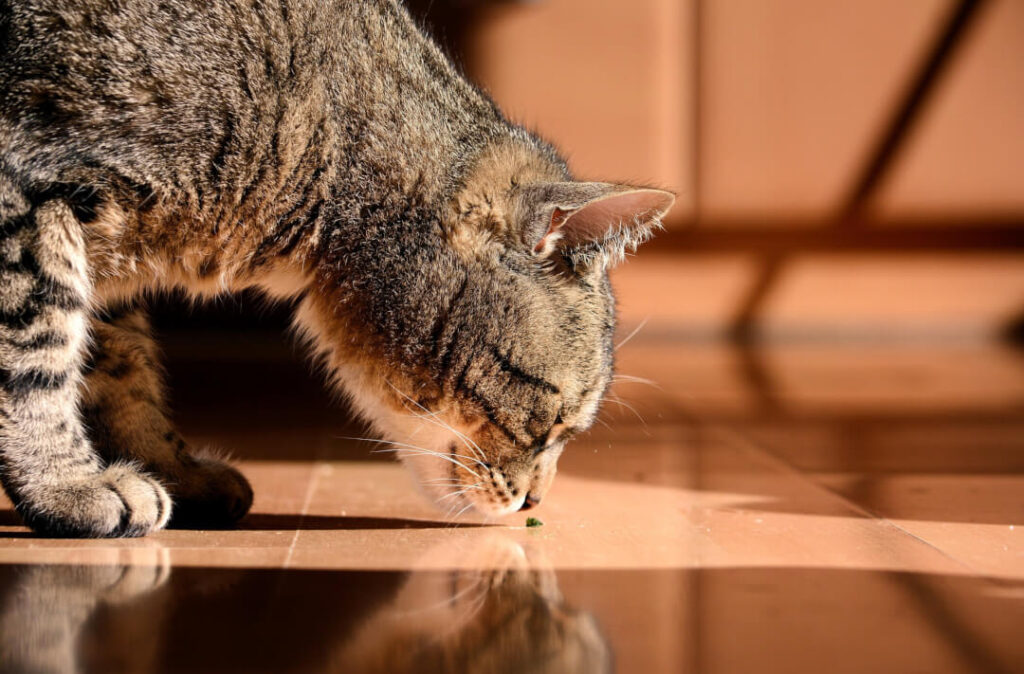
Once the cat flap has been installed, training can get under way. First, hold or fix the cat flap so that your cat can see all the way through it and can see what is in front of and behind the flap (unfamiliar things not only make us feel uncertain, but also our kitties). Now go to the outside of the flap. Take its beloved toy with you and use it to attract it from the outside.
If this doesn’t work, continue with the following step: try to lure it through with a fragrant snack. You know your cat best, and for which treats they have a weakness…
Get them used to the cat flap in spring or summer.
It is preferable to use the warmer seasons for cat flap training. For one thing, if you try in autumn or winter a lot of cold air will come into the living space when you keep open the cat flap for the first training sessions. For another thing, in spring and summer your cat will come back in cleaner – when the weather outside is less than ideal, your cat will reappear in your living room a little messy.
Likewise, if you stand outside in a gale and try to entice the cat outside, you might find your cat putting on a face. This is unsurprising since your cat’s ancestors originate from the steppe. What is the weather like there? Exactly! Warm to hot – and dry! Cats like it cosy and warm. In winter, enticing your house cat out of the warmth will be no easy task. Make it easy for yourself and wait until spring!
Playful familiarisation
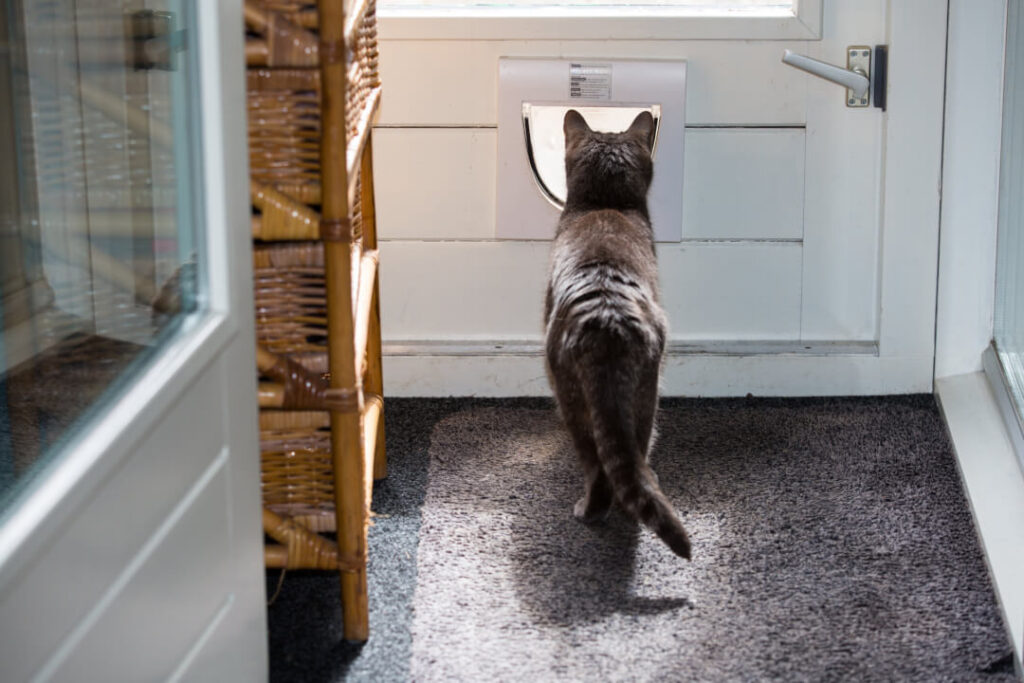
Every cat has a certain degree of strong instincts. Your cat was born with a hunting instinct that allows it to survive in the wild. A cat uninterested in prey would simply die of starvation. But the play instinct is not only there for having fun, it is also there to fulfil a vital purpose; the kitten playfully learns the skills that it will need as an adult cat. Response capacity, endurance and dexterity are all already coded in its genes, but only practice will make a cat a successful hunter.
It takes a long time and the stomach will often growl before a hunting attempts is successful. But eventually it will work out. It learns easily and effortlessly through play – which is also fun! Harness the playful instincts of your cat to get it used to the cat flap.
Motivate the cat with its favourite toy
Cats respond to things that move quickly. Movement is the key stimulus that cats can seldom resist – except for older cats or outright couch potatoes. Using a string that the cat chases after is perfect for cat flap training. In order to make it more appealing , you can tie something onto the end of the string (however, it shouldn’t be bigger or wider than the cat flap opening). Slowly pull the string from the outside through the cat flap, your kitty will follow through in tow.
This allows the cat’s initial reservations to be easily overcome by the allure (and distraction) of its favourite toy. At the same time, it learns how the mechanism works. What they can do once, they can do again. Once they have got the hang of it, they’ll think, “Yay! I made it through and am on the other side, it wasn’t so bad at all!” The breakthrough has been made and the cat has gone outside through the cat flap “voluntarily”. Bingo!
Enticing through the cat flap with a laser pointer
A laser pointer can also be helpful for tempting the cat through the cat flap in a playful way. We have already covered laser pointers, their use as well as their risks, in another article. The laser pointer can also be used like the string to lead (or rather escort) the cat with its enthusiasm for hunting through the cat flap.
Attention!
A word of caution, lest it catch the eye in the literal sense! Never direct the pointed beam at the head of your cat (or anyone) or towards any reflective surfaces! Only use the pointer with the red light – the green light is more intense.
Conditioning your cat by means of clicker training
The clever click:“click” your cat into understanding how easy it is to use this ominous cat flap. Cats are intelligent and learn quite quickly through positive reinforcement that there is a reward associated with scent when they behave well.
If your cat is already used to the clicker, you can effectively use it for flap training. Lead it – just like you would with the treat – carefully and gradually through the cat flap: When the cat hears the clicker, it knows that it has completed a task and is being rewarded for it. If it is already familiar with clicker training, this will naturally make cat flap training easier and your cat will be on the right track.
Show your cat how it’s done
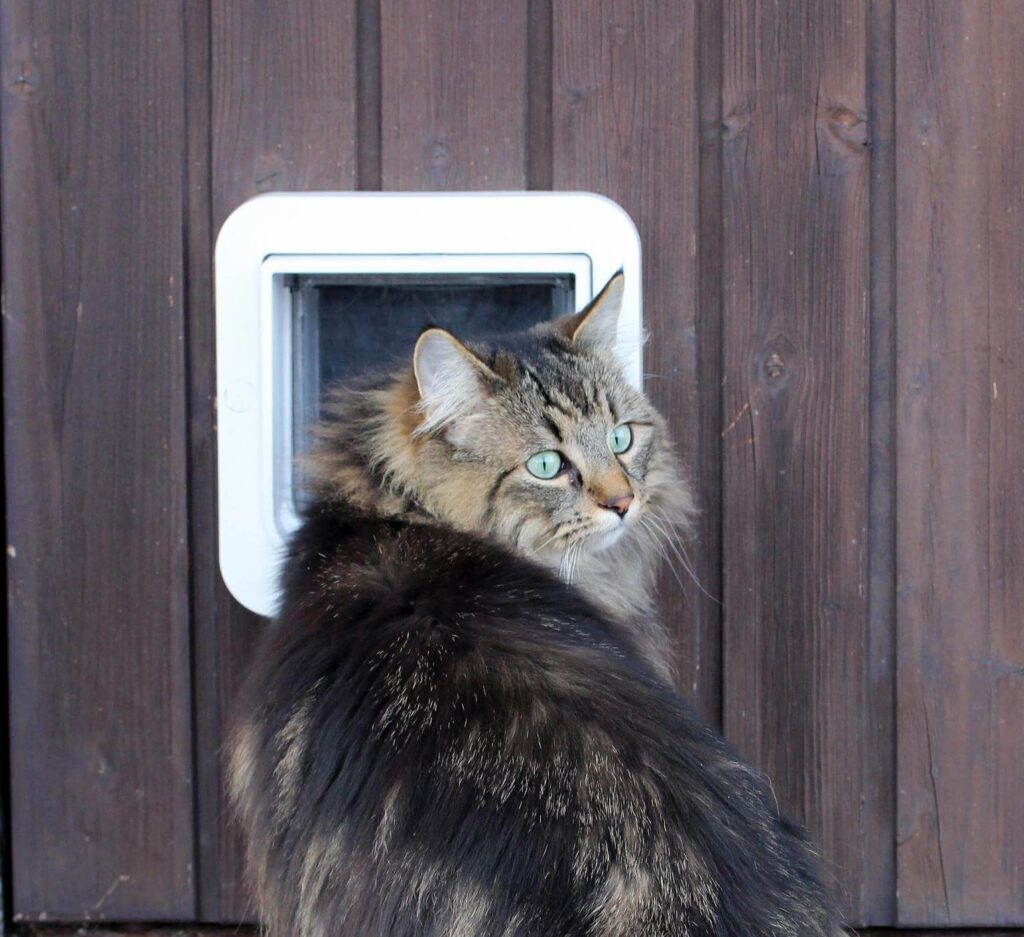
As very few cat owners can or want to squeeze through the cat flap themselves, demonstration is a bit tricky. However, you can go through the door and show your cat what is behind the door.
Then close the door and reach through the cat flap with your hand. Raise it and the cat will see that it is the same “outside” as the one behind the door. Let the cat flap swing, then hold it up with your fingers for longer. Your cat should be able to calmly take a closer look at it. Reach through the cat flap from the outside and stroke your cat when it is close enough.Please do not be tempted to take advantage of the opportunity to simply pull the cat through the cat flap… In this case, you might as well permanently seal the flap!
Let your cat be shown by another cat
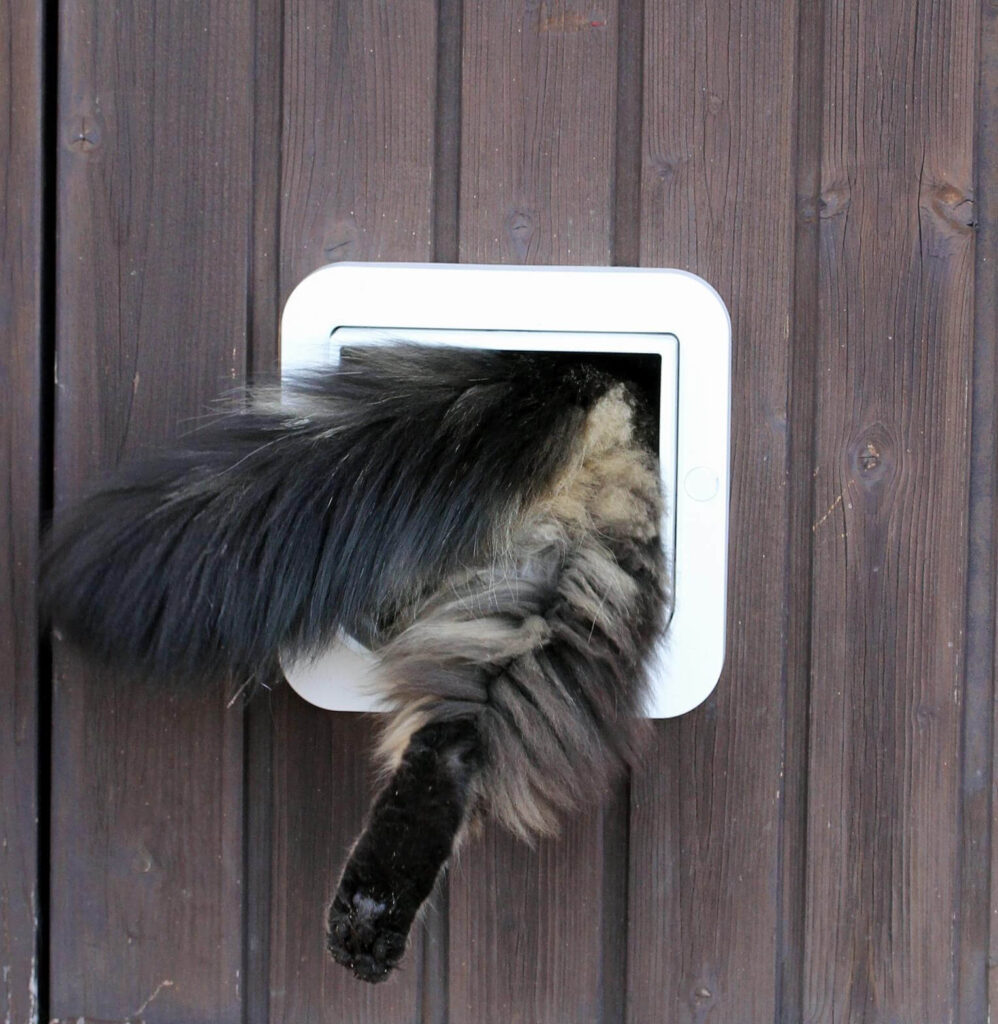
Ideally, there will be another cat in the household to demonstrate how it works. However, this is not a guarantee of success! While some slip through like it’s nothing – in, out and back again, seemingly 73 times a day – a reserved cat prefers to observe from a distance and yawn. No two cats are alike! Each has its own unique character and unmistakeable temperament. You can only “win” if you can get a feel for your cat: observe closely what it likes and doesn’t like. Are there certain behavioural patterns and preferences that are unique to this cat? If you get a feel for what makes it tick and engage with it, you’ll be halfway there – or rather half the way outdoors.
Visual familiarisation
The cat will prefer to eyeball things that are unfamiliar from a distance at first. And in any case, to the cat it will be unclear how you expect them to interact with such an object right away. If the drive to go outside is strong, your cat first needs to understand that the flap is a gateway to the big wide world. Is this possible at first glance? Yes, if you allow your cat a clear view when it first passes through:
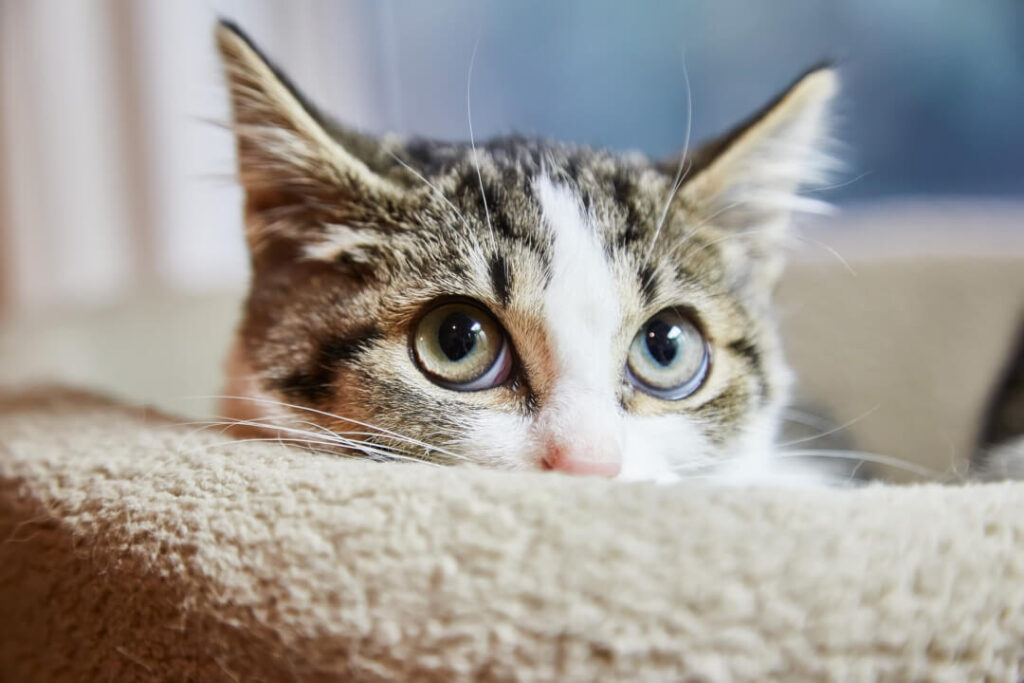
Use a transparent cat flap
Very simple, yet so effective: opt for a transparent cat door – cat flaps are available in plexiglass or safety glass. They are robust and weather-resistant. With a transparent cat flap, cats generally learn how to use their own “cat door” more quickly as they can see what is behind the flap straight away. This takes away the fear of the unknown, making many nervous kitties feel a bit braver. Your cat sees what awaits it outside – is that not temptation enough?
Fix the cat flap in the open position and let it hang further down with time
If your cat absolutely refuses to crawl through the cat flap, you can simply raise the flap up and fix it (for example, by using tape) from the start, and then gradually lower it, making sure that it is secured so it doesn’t accidentally fall down.
This lets your cat come and go freely, reducing their inhibitions and making its easier as there is no resistance to overcome. Additionally, sitting in front of the cat flap lets them smell freedom on the outside – a little breeze transports in a thousand interesting scents, making them curious for more! However, it is not so advisable in winter as a stiff breeze can quickly make your living space ice-cold.
Use cling film in the place of the cat flap
Some cats shy away from the sound or resistance of the cat flap opening and closing. This irritates them so much that they shun the cat flap. Using cling film at the start, available in thicknesses of 0.3 to 0.5 mm, lets your cat get outside without background noise and/or weight of the flap/door. First attach a piece of cling film which covers the upper third of the hole, then half of the flap and finally cover the entire cat flap. If it has noticed that it can go outside here without complications”, the first and most difficult hurdle will have been overcome! With this positive experience it will be easier for them to take the second step: passing through the actual cat flap.
Swap the cat flap for a cloth
The function of the film can also be achieved with a cloth or something similar: first fix the cat flap open and replace it with a suitable piece of fabric or thin piece of carpet. Gradually lower the cover over the opening every day until it completely covers it. You can then let the cat flap hang once again, though it is best to also leave the fabric or carpet hanging for a while. If the process works inside, you can use the same process for re-entering the home if they are also sceptical about this. If not, this is not necessary.
In this case, apply fabric or carpet to the outside and keep moving it downwards until it has grasped how it works and goes in and out of the cat flap without difficulty.
Technical familiarisation
The cat flap that you choose will primarily depend on its purpose. The simplest model goes two ways: in and out, that’s it. With a 4-way version, you can decide whether the flap remains completely open or closed, or if the cat can only leave or only enter. If you want to save energy, you should consider a cat flap with two doors as they are generally fitted with two side brushes and a magnetic lock, as these are better insulated.
The retail market offers cat flaps with a variety of locking systems. Below is a brief overview of common systems:
1. Mechanical locking system
A magnetic strip fastens the cat flap after use.
2. Magnetic locking system
In order to open the cat flap, the cat needs to wear a magnetic collar.
3. Multi-magnet locking system
The magnetic key can be coded with different closure options.
4. Electromagnetic locking system – coded or un-coded
Like the magnetic locking system but battery powered (also available as a coded model with different closure options).
5. Infrared locking system
The cat flap only works with a special infrared transmitter on the collar.
6. Locking system with chip
The cat flap recognises your cat’s chip. With this system, you ensure that only your cat can use the cat flap. The chip number of your cat is stored in the system and it “recognises” your cat. If your cat has not been chipped, you can use an RFID collar* (RFID = Radio Frequency Identification).
Remove the magnets from the cat flap in order to reduce resistance
Some cats become unsettled if the cat flap does not open without resistance; with a small amount of pressure, it remains closed and the cat remains frustrated in front of the closed cat flap and eventually ignores it completely. Many cat flaps have a magnetic locking system (see “Technical familiarisation”). Without magnets that refasten the flap after it has been opened, the flap continues to swing or opens (too) easily with a gust of wind.
In order to make passing through easier for cats, you can either mask the magnets with tape or remove them altogether – then your cat will be able to slip through easily! If they have grasped how the cat flap works after a few days, you can let the magnets do their job again.
Muffling the loudness of the cat flap with foam
When opening and closing, cat flaps make noises that can easily irritate cats that are unfamiliar with this. The click when it unlocks (when the chip has been read) and the swinging of the cat flap can also deter them. Some cats have the habit of not slipping through the cat flap in one go, more often only figuring things out with their head. However, the cat flap just keeps clicking.
Make it easier for your kitty by muffling the sound! Unfortunately, there is not a lot you can do to stop the gentle clicking after it unlocks, however, you can minimise the noise when it swings back and forth by insulating it with a bit of foam. It will pay off! Especially if your cat likes to come home at night…
Using the chip identification function
If you have opted for a cat flap with chip identification and (successfully) installed it, it is only your kitty that needs to take action. Store your kitty’s microchip information in the system – it usually takes no more than a push of a button to store its chip number – and then guide it right through the cat flap. Done!
If several cats are living with you, you can do this with each individual cat at the same time. The locking system will recognise each cat by its individual chip. The advantage: “You’re not coming in here!” This individual chip identification stops other animals from entering your living room! Once and for all, put an end to uninvited guests such as other cats, rodents or other small critters that you would rather prefer to stay outside.
What else?
What else should you observe when you are looking for a cat flap?
1. Background noise
You love your cat and sure, it is great when your cat comes and goes as it pleases thanks to the cat flap. If your night owl noisily pushes open the cat flap 73 times a night and the clattering wakes you up every time, after a few weeks you will inevitably ask yourself the question of whether it was actually the right decision?Preventing dark circles under the eyes is easy: make sure to inform yourself before purchase by finding out how loud these cat flaps are, preventing any nasty surprises. Your sweet dreams won’t be interrupted and your house cat will have access to the outside whenever it wants.
2. Air and water tightness
A cat flap that opens and closes can allow some weather to enter: pollen, wind, cold or heat depending on the time of year. There is often a hallway in between, but it is not pleasant when nature pays you an unwanted visit inside. When purchasing the cat flap, ensure that it is properly sealed – this saves energy, protects the environment and keeps your piggy bank happy. This is not to mention the fact that you’ll stay healthier. Some models only work with a type of tunnel element that protects wonderfully against wind and weather; however, not all cats are keen to crawl through such a tunnel, especially those already requiring a lot of courage to use the flap in the first place.
3. Design
Cats vary! There are small ones, big ones, fat ones and thin ones. If you have a larger cat, the conventional cat flap is usually too narrow. There is an alternative however: some cat flaps are even available in XXL sizes up to 30 cm x 50 cm (W x H)! If there are several four-legged friends in your household – perhaps a dog as well as cat – they can certainly use this door as well. Or perhaps it’s “cats only”, so that only kitties can go in and out – as you wish! This can be regulated with a chip or RFID tag* (see “Locking system with chip” above).Cat flaps can be installed (almost) anywhere: in walls (using a tunnel element), windows, terrace doors, fixed glass panes and doors.
4. Safety
Select a cat flap that is perfectly suited to the size of your cat and is not bigger than it needs to be. Consider where to install the cat flap: Depending on where you install it and how it is mounted, there may be safety risks* as they invite burglars to try their luck. If windows or door handles can be reached through the cat flap, thieves will have an easy job! When purchasing a cat flap, it is better to choose one that has security features (for example electronic cat flaps with sensors which only open for your cat). Install the cat flap out of reach and secure doors and windows. Installation in the wall is perfect but it cannot be done everywhere without a lot of work, particularly if you are a renter.
*Careful: If burglars are able to reach the door or window handle through the cat flap, any losses might not be covered by insurance!
Tip:
- Always lock the front door properly when you leave the house or the flat.
- Close the windows
- CCTV and apps
Those who want to play it safe can monitor their home at all times using apps and video camera. The advantage: you can see what is going on at home at all times.
5. Cat flaps in rented flats
From a legal point of view, the installation of a cat flap involves a structural change. If you are living with your kitty in a rented flat, you should ask your landlord for permission before installing a cat flap (the same goes for cat nets, see related section). If you end up moving, you normally need to return the flat to its original state, which means removing cat flaps and returning doors, walls or windows to their original state. You can remove window panes, glass and wooden doors, deposit them in a protected place and simply install them again when moving out.
To conclude: the best cat flaps for 2018
And now? Which one should I go for and which is the best cat flap of them all? Which are the top contenders?
As there is an abundance of flaps and manufacturers and it can take hours (or days, or even months) to wade through all the comparison tests and consumer ratings, here we present a list of some of the best cat flaps:
Bright prospects:
- In the near future you will (finally) have plenty of time for yourself as you will not have to constantly open and close doors.
- You will no longer hear any heart-breaking miaows while watching opera arias or football.
- You’ll be more fit and rested as there are no more sleepless, bleary-eyed nights when you are always on the go to open the door for the returnee.
- Now you can calmly settle in for the night – your kitty can come home without any work on your part.
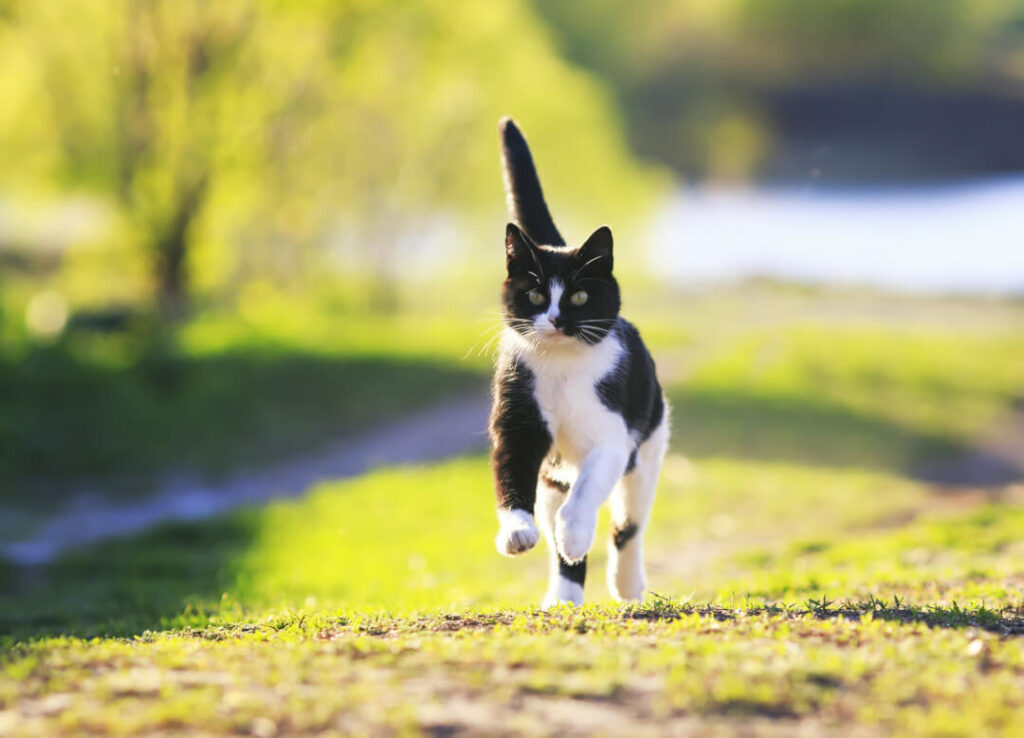
But let’s face it, it’s about your house cat and its freedom:
They will love it! Going on the prowl, visiting the neighbours’ cats or just lazing around in the sun on the windowsill… there’s nothing like the fun of a catwalk!
Purchasing and using your cat flap will be a great choice which you’ll benefit from for years!
IT WORKS!
